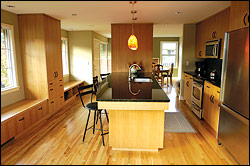Some mothers tell their daughters to establish a career. Other mothers tell their daughters to find a man and produce grandchildren. But Susan Fujita of Mercer Island urged her two daughters to kick start adulthood by investing in real estate as soon as they could swing it—regardless of whether they had rings on their fingers or had fully figured out their careers. “We sensed the market was going to really take off,” she says. “I told them just go out and take a look, have a gauge for when you are ready.”
Thanks to encouragement from Mom—and a little advice from Dad, an engineer with a love of architecture and a willingness to help with demolition—the Fujita sisters are both proud owners of swell Seattle bachelorette pads. The two have spent a collective $300,000 over the past three years updating their homes with new kitchen and dining spaces, warmer colors, and homey wood windows and cabinetry.
Sure, that’s some major bank. But these days, more and more women are taking on both a mortgage and a remodel themselves. The Fujita sisters are among the swelling population of single women who have become homeowners over the past seven years. (See related story, p. 34.)
So how’s a single gal to find a house in Seattle these days? And, more importantly, can she set it up in style? As the Fujita sisters’ story illustrates, that all depends on timing, budgets, and working with a sympathetic architect (the same one, as it happens). Both siblings said they shopped for properties in good locations—but what they found and what they paid for it was a function of when they bought. Then came some major improvements.
She’s a brick house
Leslie Fujita, a 35-year-old pharmacist, bought her 1940s-era Genesee Park brick cottage in 1995, going in on the $150,000 purchase with her then-boyfriend and with a little help from the folks. She was 25 at the time and fresh out of pharmacy school. She knew the 2,000-square- foot house, with its boxy shape, cramped upper-floor rooms, and goofy brown paneling, was definitely a fixer, aesthetically speaking. But it was the right size, had a roomy yard, and was in a safe neighborhood near Lake Washington. She and her beau (briefly her husband, now an ex) put $10,000 worth of cosmetic work into it, mostly painting and ripping out paneling. For the most part, they lived there as is.
But by 2004, Leslie was living there solo and ready to make some changes. She wanted to open up the space and also create more of a view of the lake. Naturally, she called Patricia Brennan, a prominent Seattle architect who had helped Leslie’s parents renovate their 1970s Wendell Lovett home a few years earlier. Brennan also had directed her sister Tiffany’s remodel, as described later.
Brennan says the Fujita sisters were responsive clients, good listeners who developed their own ideas and collaborated well throughout the process. “It started with ‘Let’s just do the upstairs,'” Leslie explains. “Then I said, ‘Let’s do downstairs, too.'” And slowly but surely, Leslie embarked on a complete $200,000 remodel—using some elements of the design Brennan did for her sister’s and her parents’ houses, such as custom wood cabinetry by Jonathan Paul and reversing rooms to create more open space.
Upstairs, Brennan and Leslie opened up a cramped bedroom and moved a wall so a window nook could face east to the lake. Giant closets, a bathroom with limestone floors and double sinks, and a second office are upstairs. To save on costs, Leslie and her father handled portions of the demolition. She also opted to not raise the roof to create higher ceilings, giving the bedroom and other second-story rooms a cozy feel. Costs cropped up anyway—contractors discovered old knob-and-tube electrical wiring, a major fire hazard.
Leslie says it was initially difficult to articulate how she might reconfigure her home, given its hard-to-rearrange brick masonry. She subsequently held a focus group with her sister, mother, and a friend to debate how the downstairs kitchen and dining room could be better combined.
The result is warm and casual: a dining room partitioned by custom-built bookcases; and a kitchen that faces the front of the house and is visible from the street. Three bright glass lamps hang above a black granite island with seating for four; the stainless appliances and custom anigre wood contrast well against the other colors. “I wanted this to be contemporary but casual,” says Leslie. “I like things open and bright.”
For decor, she chose many Asian touches and accents. Two cushioned benches that line the kitchen area have open shelves for guests to remove their shoes, Japanese-style. Her walls are a soothing jade green—contrasted on one side of the living room by a deep red wall recommended by her sister, Tiffany. And the remodel, just completed last month, will soon be home to both Leslie and her boyfriend, who is about to move in with her.
While she’ll share the home once again, Leslie believes the look is uniquely hers. “He wasn’t involved at all,” she concludes with satisfaction.
Modern in Maple Leaf
Tiffany Fujita, 37 and a Microsoft employee, waited until 2001 to buy. She would have bought sooner if she could have, she explains, but stayed out of the market until she was financially prepared. Buying as a single gal didn’t bother her one bit, especially since she knows some couples who have split up, with only one winner taking the house. “I wasn’t going to wait for a guy to buy,” she declares. “If I could’ve done it earlier, I would’ve.”
Tiffany looked in Fremont, Ballard, and as far north as Northgate before locating her present home in Maple Leaf. While the then-cooling economy made home buying easier than it had been during the boom, it didn’t mean prices went down. She spent $250,000 on her 1,200-square-foot 1940’s house, which has three bedrooms and one and a half bathrooms.
She knew she’d want to change the kitchen and dining room, but she didn’t think she could afford to do that upon moving in. Her parents, however, told her it’d be less painful to do the work before she settled in than to go through the disruption of a remodel. They also recommended Brennan, by now the official Fujita family architect.
“I was like, ‘I can’t afford Pat!'” Tiffany remembers. But after talking with Brennan and doing a lot of her own research to source affordable materials (such as her IKEA cabinetry and affordable ceramic “subway”-style backsplash kitchen tiles), she realized she could swing it, after all. Not only could she swing the price, but she could swing the kitchen and dining room around, add new doors and windows, reverse the staircase to the basement, and plunk a deck out back.
Originally, the dining room was in the back of the house in a window-lined room, while the kitchen was in the dark interior. Tiffany’s father liked the dining room’s placement, but she decided she’d spend more time in the kitchen. At Brennan’s suggestion, flipping the kitchen and dining areas allowed the kitchen-as-social-center to gain more light and space, not to mention double doors to her deck for summer entertaining. Wood-frame windows and doors bring more warmth into the area. The less-trafficked dining room is now reserved for special occasions, or a place to form a buffet during a party.
Work at Tiffany’s home took more than four months. But sitting at her counter and surfing those troublesome election results, Tiffany looks completely at peace in her surroundings. Her kitchen is a place to eat, check e-mail, and chat.
It is also indicative of how Brennan’s clients, especially single women, are reconfiguring their homes to be social and open—more modern and reminiscent of lofts. Houses built in the 1940s and 1950s, as the Fujita sisters’ homes were, were configured for traditional families and had discrete spaces for specific uses. But as traditions and household compositions change, so, too, do the design considerations for a successful remodel.
It’s no surprise that both Fujita sisters are pleased with their renovations— Brennan was in the same solo situation when she refurbished her own 1914 Ballard bungalow in the 1980s. What was then a relatively rare, pioneering act for a woman now looks like the beginning of a burgeoning trend.







